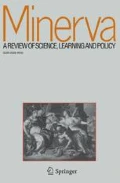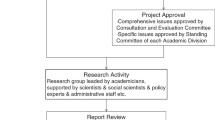Abstract
The president’s science advisor was formerly established in the days following the Soviet launch of Sputnik at the height of the Cold War, creating an impression of scientists at the center of presidential power. However, since that time the role of the science advisor has been far more prosaic, with a role that might be more aptly described as a coordinator of budgets and programs, and thus more closely related to the functions of the Office of Management and Budget than the development of presidential policy. This role dramatically enhances the position of the scientific community to argue for its share of federal expenditures. At the same time, scientific and technological expertise permeates every function of government policy and politics, and the science advisor is only rarely involved in wider White House decision making. The actual role of the science advisor as compared to its heady initial days, in the context of an overall rise of governmental expertise, provides ample reason to reconsider the role of the presidential science advisor, and to set our expectations for that role accordingly.
Similar content being viewed by others
Notes
Some of these conflicts are chronicled in Mooney (2005).
These numbers were arrived at by searching Science for editorials authored by its chief editors, Daniel Koshland, Floyd Bloom, and Donald Kennedy, from January, 2003 to December, 2008. The editorial critical of the Clinton Administration focused on its policies related to needle exchange programs.
Marburger’s opinion about the significance of this move can be found in the transcript of his public interview during a science advisor lecture series that we organized at the University of Colorado, located at http://sciencepolicy.colorado.edu/scienceadvisors/marburger_transcript.html.
Transcripts of those presentations are available online and are referenced throughout this article.
Notably absent from the scholarly literature that discusses the history of the president’s science advisor is mention of the “Stewart Committee” of the late 1940s which recommended a science advisor to the president (for a cursory mention see Blanpied 1995).
As quoted in Grossberg (1974, p. 29).
Another factor undoubtedly influencing the president’s receptivity to a proposal to establish a science advisor was President Truman’s decision to develop an H-bomb contrary to the advice of leading scientists, and subsequent efforts by the Eisenhower Administration to remove J. Robert Oppenheimer from his advisory roles (Damms 2000; Greenberg 2001).
That the first science advisor was not a scientist does not appear to be widely appreciated, and it is not widely advertised in the science community that Killian did not earn a doctorate. Killian had been awarded an honorary doctorate from Middlebury College in 1945, see Anonymous (1945). Killian was later awarded honorary degrees from Union College, Drexel Institute of Technology, and the College of William and Mary, see Anonymous (1957).
Richard Russell’s biography can be found here: http://www.ostp.gov/cs/about_ostp/richard_m_russell.
Contemporaneously, William T. Golden wrote, “As to how many top echelon or key scientists there are, around whom any mobilization would devolve, [Lee] DuBridge said that there is a continuous spectrum and it would be difficult to decide where to draw the line. However, it appears that the number is probably somewhere between 20 and 200” (Golden 1950b). GAO (2004) documents that the explosion of advice to the federal government has not been restricted to the scientific or technical, reporting that in 2003 there were 948 advisory committees with 62,497 members.
This episode in the history of scientific advice, and the sources for the quotes above, are documented in Greene (2007).
Ibid.
Ibid.
Ibid.
Ibid.
Ibid.
Ibid.
The only science advisor to play an active role in a presidential campaign appears to be Jerome Wiesner, who participated in John Kennedy’s presidential campaign (Grossberg 1974).
Since World War II, if not longer, science has played an important role in international relations (see, e.g., Doel and Harper 2006; Krige and Barth 2006; Miller 2006). As Donald Hornig told us, “Science is a wonderful lubricant for foreign policy initiatives.” For policy makers, the scientific and technological are central to some of the most important questions that they face in international politics, such as trade, defense, and health, while for scientists participation in international relations offers the tantalizing prospect of “additional resources while enhancing their scientific authority and social capital” (Krige and Barth 2006). This topic has been well documented elsewhere (e.g., see the excellent review of Krige and Barth 2006), and thus is not covered here. However, many of the science advisors did refer to international relations as a key element of their tenure.
Ibid.
Ibid.
References
Anonymous. 1945. Middlebury gives Killian honorary doctor’s degree. The Tech 65: 4, June 1. http://www-tech.mit.edu/archives/VOL_065/TECH_V065_S0085_P004.pdf.
Anonymous. 1957. Degree for Killian. The Tech 77: 1, April 26.
Blanpied, William A. 1995. Introduction to impacts of the early Cold War on the formulation of U.S. science policy. Washington, DC: AAAS. http://www.aaas.org/spp/cstc/pne/pubs/golden/golden.pdf.
Broad, William. 2001. Government reviving ties to scientists. The New York Times, November 20.
Bromley, David. 1994. The president’s scientists: Reminiscences of a White House science advisor. New Haven: Yale University Press.
Bronk, Detlev. 1974. Science advice in the White House: The genesis of the president’s science advisers and the National Science Foundation. Science 186: 116–121. doi:10.1126/science.186.4159.116.
Brumfiel, Geoff. 2004. US science policy: Mission impossible? Nature 428: 250–251. doi:10.1038/428250a.
Damms, Richard. 2000. James Killian, the technological capabilities panel, and the emergence of President Eisenhower’s “scientific-technological elite”. Diplomatic History 24: 57–78. doi:10.1111/1467-7709.00198.
Doel, Ronald, and Kristine Harper. 2006. Prometheus unleashed: Science as a diplomatic weapon in the Lyndon B. Johnson administration. Global Power Knowledge: Science and Technology in International Affairs 21: 66–85.
Dupree, A.Hunter. 1963. Central scientific organization in the United States government. Minerva 1: 453–469. doi:10.1007/BF01107188.
Eisenhower, Dwight. 1957. Text of address by the President delivered from the oval office in the White House on “science in national security”. November 7: 6. http://www.eisenhower.utexas.edu/dl/Sputnik/PresidentialAddressNov71957pg6.pdf.
Finney, John. 1957. Killian takes the oath as U.S. scientific coordinator. The New York Times, November 16: 1.
GAO (Government Accountability Office). 2004. Federal advisory committees: Additional guidance could help agencies better ensure independence and balance. GAO-04-328.
Glanz, James. 2001. The nation: Blue sky; sure, it’s rocket science, but who needs scientists? The New York Times, June 17.
Glanz, James. 2004a. At the center of the storm over Bush and science. The New York Times, March 30.
Glanz, James. 2004b. Scientists say administration distorts facts. The New York Times, February 19.
Godin, Benoît. 2006. The linear model of innovation: The historical construction of an analytical framework. Science, Technology & Human Values 31: 631–667. doi:10.1177/0162243906291865.
Golden, William. 1950a. Conversation with Dr. Lee A. DuBridge, president of California Tech, Dr. James R. Killian, Jr., president of Massachusetts Institute of Technology, and Irvin Stewart, president of the University of West Virginia. October 25. http://archives.aaas.org/golden/pdf/049_19501025.pdf.
Golden, William T. 1950b. Mobilizing science for war: The science advisor to the president, memorandum for the president. December 18. http://archives.aaas.org/golden/pdf/393_19501218.pdf.
Greenberg, Daniel. 2001. Science, money, and politics: Political triumph and ethical erosion. Chicago: University of Chicago Press.
Greene, Benjamin. 2007. Eisenhower, science advice, and the nuclear test-ban debate, 1945–1963. Stanford: Stanford University Press.
Grossberg, Israel. 1974. The special assistant to the president for science and technology, 1957–1968. Doctoral dissertation, New York University.
Guston, David. 2009. Science, politics, and two unicorns: An academic critique of science advice. In Presidential science advisors: Perspectives and reflections on science, policy and politics, eds. Pielke Jr., Roger, and Roberta, Klein (in press).
Hart, David. 1998. Forged consensus: Science, technology, and economic policy in the United States, 1921–1953. Princeton, NJ: Princeton University Press.
Kevles, Daniel. 1977. The National Science Foundation and the debate over postwar research policy, 1942–1945. Isis 68: 5–26. doi:10.1086/351711.
Killian, James. 1982. Sputnik, scientists, and Eisenhower: A memoir of the first special assistant to the president for science and technology. Cambridge: MIT Press.
Kleinman, Daniel Lee. 1994. Layers of interests, layers of influence: Business and the genesis of the National Science Foundation. Science, Technology & Human Values 19: 259–282. doi:10.1177/016224399401900301.
Kleinman, Daniel Lee. 1995. Politics on the endless frontier: Postwar research policy in the United States. Durham: Duke University Press.
Krige, John, and K. Kai-Henrik Barth. 2006. Introduction: Science, technology, and international affairs. In Global power knowledge. Science and technology in international affairs. Osiris, Second Series, vol. 21. Chicago: University of Chicago Press.
Lamson, Robert. 1955. The present strains between science and government. Social Forces 33: 360–367. doi:10.2307/2573008.
Lawton, Fred. 1950. Letter to William T. Golden. September 19. http://archives.aaas.org/golden/pdf/405_19500919.pdf.
Leiserson, Avery. 1965. Scientists and the policy process. The American Political Science Review 59: 408–416. doi:10.2307/1953058.
Marburger, John. 2004. Statement of the honorable John H. Marburger, III on scientific integrity in the Bush administration April 2, 2004. http://www.ostp.gov/html/ucs/ResponsetoCongressonUCSDocumentApril2004.pdf.
Miller, Clark. 2006. An effective instrument of peace: Scientific cooperation as an instrument of U.S. foreign policy, 1938–1950. Global power knowledge. Science and technology in international affairs. Osiris, Second Series 21: 133–160.
Mooney, Chris. 2005. The republican war on science. New York: Basic Books.
Mullins, Nicholas. 1981. Power, social structure, and advice in American science: The United States national advisory system, 1950–1972. Science, Technology & Human Values 7: 4–19. doi:10.1177/016224398100600402.
Neumann, Frank, and Harry Keaton. 1953–1954. Congress and the faithful execution of laws. Should legislators supervise administrators? California Law Review 41: 565–595. doi:10.2307/3478195.
Pielke Jr., Roger. (ed.). 2004. Report on the misuse of science in the administrations of George H.W. Bush (1989–1993) and William J. Clinton (1993–2001). By the Students in ENVS 4800: Maymester, University of Colorado, June.
Pielke Jr., Roger, and Roberta, Klein (eds.). 2009. Presidential science advisors: Perspectives and reflections on science, policy and politics (in press).
Pielke, Roger. 2007. The honest broker: Making sense of science in policy and politics. Cambridge: Cambridge University Press.
Press, Frank, and Philip M. Smith. 2009. Science and technology in the Carter Presidency. In Presidential science advisors: Perspectives and reflections on science, policy and politics, eds. Pielke Jr., Roger, and Roberta, Klein (in press).
Raloff, Janet. 1981. Mr. Keyworth goes to Washington. Science News 120: 45–46. doi:10.2307/3966032.
Rigden, John. 2007. Eisenhower, scientists, and sputnik. Physics Today (June): 49.
Sarewitz, Daniel. 2007. Does science policy matter? Issues in Science and Technology (Summer): 31–38.
Schultz, William. 2001. Advising the president. Chemical and Engineering News 79: 23–27.
Sherwood, Morgan. 1968. Federal policy for basic research: Presidential staff and the National Science Foundation 1950–1956. The Journal of American History 55: 599–615. doi:10.2307/1891016.
UCS (Union of Concerned Scientists). 2004a. Scientific integrity in policy making: An investigation into the Bush administration’s misuse of science. Union of Concerned Scientists. March. http://www.ucsusa.org/assets/documents/scientific_integrity/RSI_final_fullreport_1.pdf.
UCS (Union of Concerned Scientists). 2004b. Scientific integrity in policy making: Further investigation of the Bush administration’s misuse of science. Union of Concerned Scientists. July. http://www.ucsusa.org/assets/documents/scientific_integrity/Scientific_Integrity_in_Policy_Making_July_2004_1.pdf.
Waxman, Henry. 2003. Politics and science in the Bush administration. U.S. House of Representatives, Committee of Government Reform. Political Science (Wellington, N.Z.) (November): 13. http://democrats.reform.house.gov/features/politics_and_science/pdfs/pdf_politics_and_science_rep.pdf.
Wiesner, Jerome. 1963. The role of science in universities, government, and industry: Science and public policy. Proceedings of the National Academy of Sciences of the United States of America 50: 1201–1207. doi:10.1073/pnas.50.6.1201.
Woolley, John, and Gerhard Peters. 2007a. The American presidency project. Santa Barbara, CA: University of California (hosted), Gerhard Peters (database). http://www.presidency.ucsb.edu/ws/?pid=5968. Accessed 10 August 2007.
Woolley, John, and Gerhard Peters. 2007b. The American presidency project. Santa Barbara, CA: University of California (hosted), Gerhard Peters (database). http://www.presidency.ucsb.edu/ws/?pid=30416. Accessed 10 August 2007.
Yankelovich, Daniel. 2003. Winning greater influence for science. Issues in Science and Technology 19 (Summer).
Author information
Authors and Affiliations
Corresponding author
Rights and permissions
About this article
Cite this article
Pielke, R., Klein, R. The Rise and Fall of the Science Advisor to the President of the United States. Minerva 47, 7–29 (2009). https://doi.org/10.1007/s11024-009-9117-3
Received:
Accepted:
Published:
Issue Date:
DOI: https://doi.org/10.1007/s11024-009-9117-3



